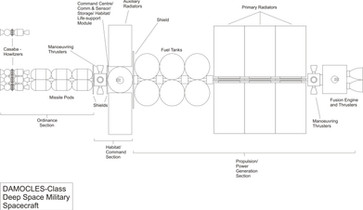HOME | DD
 NK-Ryzov — Angel of Io (ship) [WIP]
NK-Ryzov — Angel of Io (ship) [WIP]

Published: 2019-09-14 04:05:07 +0000 UTC; Views: 4588; Favourites: 22; Downloads: 12
Redirect to original
Description
This here is some concept art for what the average, “working class” IPV (interplanetary vehicle) is like, circa 2285, in Overheaven. The Angel of Io is a Vestian-built cargo vessel crewed by Belters and known to make various deliveries between Vesta and Luna.>So, for starters, Star Trek/Star Wars-level artificial gravity is not present in Overheaven; most of the Angel is micrograv (zero-gravity), with two rotating cgrav (centrifugal gravity) sections; artigrav systems utilizing “Heim-Podkletnov fields” (HPF), are reserved for the bridge of the ship (more on that in a bit), due to the sheer amount of energy these high-end systems require.
>There is no FTL in Overheaven. Period. The Angel is still rather fast, however - able to reach Mars from Earth in a week and a half.
>The habitat wheel has two decks, with a medical bay, showers, a cafeteria, lounge, cryopods, gym, storage units, workshops and living quarters for crew and passengers. By rotating, it generates the equivalent of 1g of gravity via centrifugal force.
>The lounge includes a Yesli 6000 virspace console, which supports most eighth- through eleventh-generation small-scale virspaces. All you do is lie on a couch, insert a wired jack into the interface plug implanted into the back of your neck, toggle the AR interface to start the simulation. As your body enters REM sleep, you will be “transported” to a virtual world just as subjectively “real” as the one you already take for granted - beyond simply a show for your eyes or ears, you will taste, touch and smell things in virspace. Virspace servers are popular for IPV crews, since spacer jobs often consist of doing nothing for hours or even days on end. So to alleviate boredom, they take a break to slay dragons and stuff like that.
>While some crew members aboard the Angel might be volari (micrograv-adapted humans), most are not, and need to spend and average of six hours in the habitat ring or bridge per day, which, in space, is just an arbitrary period of 24 hours, indicated by the dimming of the ship lighting from white to red. Time spent in the hab wheel is to avoid the effects of long-term micrograv exposure.
>The crew of the Angel fluctuates over time, since many spacers only join crews for short stints rather than long-term commitments, or join crews as a way of paying their way to some far-off destination that happens to be where the ship is heading. Typically, the crew numbers around fifteen, sometimes only seven, or as many as twenty, with the minimum requirements for running the ship being as low as five.
>The cargo wheel is supposed to be used for storing micrograv-sensitive cargo, though the crew of the Angel has converted one of the lobes into an impromptu brig.
>There are no windows on the Angel, since these are structural weaknesses for the ship and given the number of things in space that could blind you, it makes more sense to just have a shit-ton of cameras on the outside of your ship, and use screens to see outside instead. It’s the 23rd century, after al, so the HD screens of the future likely look more crisp and real than a window would.
>Because there are no windows, the Angel of Io has no stereotypical sci-fi command bridge. Instead, the command center is a spherical room placed deep inside the ship, which has energy-whore HPF systems (for reference, one of the ship’s two fusion reactors is there to power the engines and the rest of the ship’s systems, the other one is just for the HPF generators in one relatively small room) pulling everything towards its concave surface, because vanilla artificial gravity is boring. The command deck is loaded with computers, monitors, holographic displays and augmented reality overlays synched with implants inside the bodies of the crew. It’s a bit of a cyberpunk, MC-Escher-looking scene; if your buddy on the other side of the room wants a smoke, you throw the cigarette up and they’ll catch it; there are six hallways leading to the bridge, which are lined with HPF generators of growing intensity, from 0.1g to 1g, and people are regularly walking into the bridge upside down.
>While most operations aboard the ship are handled and overseen by a human crew, vessels like the Angel normally also have an on-board integrated turingrade AI, known as a "figurehead". The Angel’s figurehead, Io, might have the ship as her body (she also has a humanoid avatar which can appear via monitors, holos and AR), but figureheads are nothing if not loyal to their captains - less out of obligation or programming, than out of a sense of honor and personal integrity. While most of the time she basically acts as a personal assistant to the captain and crew, and aids command in running the ship’s systems (and serves as the “face” of the ship when marketing its services), all of the ship’s automated processes are hers to oversee, and in the event of an emergency, she can control the entire vessel. Should the Angel get stuck in a populated planet’s gravity well and start to enter the atmosphere, for example, Io will prioritize evacuating the crew and happily go down with the ship, self-destructing in the upper atmosphere to prevent a potential extinction-level impact. Her only regret would be that she could no longer be with her crew.
>The micrograv areas of the ship are where most of the daily maintenance work is conducted, and these areas are mostly covered with cargo netting, hand/foot holds, emergency breach patches, and the occasional screen displaying the outside. In microgravity, it's common for spacers to work barefoot and learn how to use their toes and feet to grab and use tools; learning how to move through zero-gravity and overcoming motion sickness, is known as getting one's "space legs". Volari take this to the next level - after many generations of living in micrograv, they've augmented their bodies with prehensile and hand-like feet.
>For propulsion, the vessel has eighteen VASIMIR (VAriable Specific Impulse Magnetoplasma Rocket) engines; VASIMIR engines are electrothermal thrusters, which use radio waves to ionize and heat an inert propellant (hydrogen being the most widespread), then a magnetic field to accelerate the resulting plasma, generating thrust. The Angel’s eighteen VASIMIR’s are powered by two aneutronic fusion reactors. Meanwhile, in the front, we have twenty chemical RCS thrusters, which are used for maneuvering the vessel. When the Angel needs to brake and settle in orbit or prep for docking with a station, it throttles RCS in one direction, to flip the whole ship backwards and then use the VASIMIR thrusters to brake for final approach.
>The Angel’s twelve radiator wings are present to assist with cooling the VASIMIR engines, as well as the rest of the heat that the ship generates - a genuine hazard in space.
>For conducting repairs on the ship’s exterior, the Angel has a simple “raft”-type spacecraft; it looks like OTL’s International Space Station, but is packed with much more advanced technology. This rudimentary spacecraft is all micrograv and has six small thrusters for maneuvering around. Rafts are modular craft, with no two ever really looking much alike; this one here, lovingly nicknamed “Shitcan”, has seven modules; the largest is the airlock, with the rest mostly used for storing tools, handling on-board life support and steering the thing; two of the modules each have two sets of robotic arms to assist space-suited work crews. While not especially common, rafts are sometimes known to have figureheads on-board, and Shitcan is one such raft, with a figurehead manifesting as a helpful (if self-deprecating) anthropomorphic raccoon, also named Shitcan.
>Because the Angel of Io is too big and awkward to enter a planet’s atmosphere and not die a fiery death, the captain of the Angel has had the good sense to have at least one IAV (interhemispheric vehicle).
>The shuttlecraft in question is a 2265-model Peregrine, a mid-sized IAV produced by Serrano Interstellar, of Luna. Nicknamed “Lucy!”, the Peregrine is built to navigate low and high orbit, and to enter and fly within atmospheres. Entering an atmosphere for a Peregrine is as easy as falling and not dying, but because of size considerations, Lucy!’s NERVA nuclear-thermal rockets are insufficient for leaving Earth, Venus or Mars’ gravity wells, and so upon landing on a planet surface, Lucy!’s crew have to rent strap-on boosters from the local spaceport, mount them on the Peregrine’s hardpoints, use them to reach the upper atmosphere, fire its dual NERVA’s and hit orbit; the boosters would then detach and use the remaining fuel to fly themselves back to the spaceport and land themselves. Lucy! also has her own figurehead, Lu, whose avatar changes from slutty half-naked woman to slutty half-naked man, depending on who they’re talking to.
























